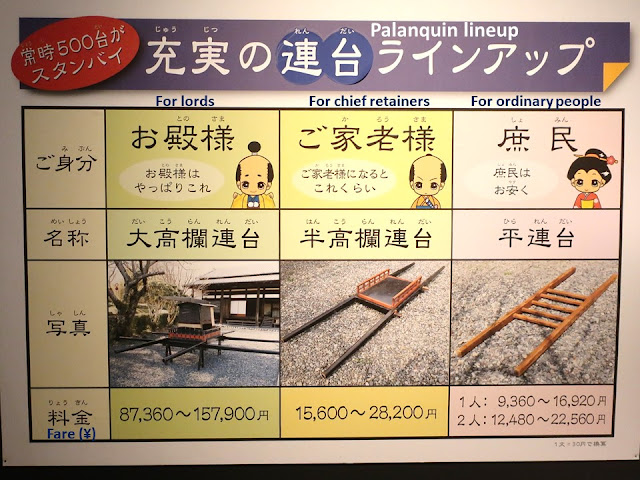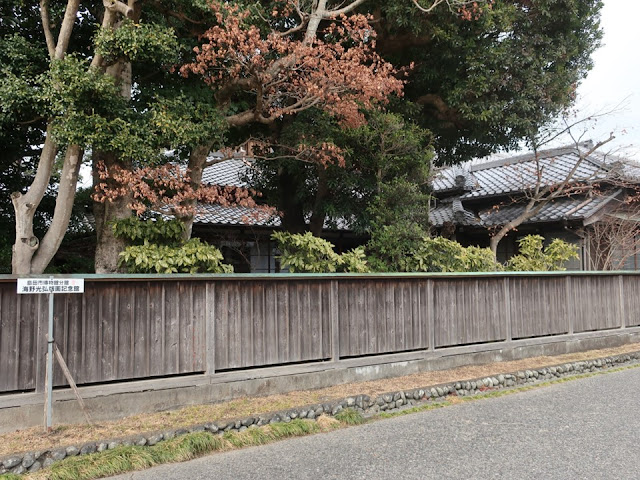The museum is beside the Ohi River. In the Edo period (1603~1868), there was no bridge at the river because of the strategic reason. Carriers helped people to cross the river. They carried travelars on their shoulder, or they shouldered a palanquin. There is a palanquin which you can get on and take photos. Four carriers shoulder you.
The service suspended while the water level was high, therefore many travelers stayed at Shimada on such an occasion. The museum shows us the trip back then, and the annex shows us local folklore and so on.
江戸時代、戦略的な理由で橋が架けられず、肩車や連台で渡っていた大井川の前に博物館があります。博物館の前には、連台に乗って写真を撮れるモニュメントもあります。水かさが増すと大井川は「川留め」となりましたが、おかげで島田宿は賑わいました。本館では旅のようすなどを、分館では、民俗資料などを展示しています。
There is a levee in front of the museum and we cans see the Ohi River.
博物館の前の堤防に上がると、その先は大井川です。
There is a rebuilt post town in which there are inns and so on.
堤防から振り返ると、復元された島田宿の街があります。
Although it is a huge museum, the area of the permanent exhibition room is as same as two class rooms; it’s easy to watch. It is written “Trip and travelers” on the curtain at the entrance of the room.
博物館は巨大ですが、常設展示室は教室二つぐらいの広さで見学しやすいです。暖簾には「旅と旅人」と書かれています。
Once going inside the room, you find the panel of travelers in the Edo period (1603~1868).
展示室に入るとすぐに江戸時代の旅人たちのイラストが展示されています。
The panel above shows the outline of Shimada post town. There were 1,461 buildings and 6,727 people; it was the seventh largest post town on Tokaidou highway.
島田宿の概要説明パネルです。人口6,727人、家数1,461軒、東海道で7番目に人口が多い宿場でした。
There were various kinds of palanquins. A real one for ordinary people is exhibited. The fare depended on the water level.
平連台の実物も展示されています。水位によって料金が変わります。
The picture above shows that the shogun crossed the river in 1863. Thirty carriers and fifty workers were engaged in to carry him. It was in March, water was cold.
徳川将軍の川越の絵です。1863年に徳川家茂が上洛した時は、川越人足36人で担ぎ、水切り人足50人と共に進みました。旧暦3月、水が冷たそう。
There were ten groups of carriers, and they were at a waiting house. A traveler bought a ticket (lower right) at the control office (upper left) and passed to the carrier. One carrier ticket was required for each carrier. One palanquin ticket was needed to use a palanquin. The simple tickets were oiled-papers. I was moved because such papers still remain. Btw, the carries worked as farmers when they were not engaged.
Across the river was troublesome, moreover it depended on the water level and the weather.
人足たちは10組に分けられ番宿で待機しました。旅人が川会所(左上)で購入した札(簡単な紙ですが防水のために油をしみこませています。よく残っていました)を受け取り、川を越しました。人足一人につき川札一枚、台一つにつき台札一枚です。彼らは人足に出ない日は農業などで暮らしていました。
確かに川越えは大変です。しかもお天気次第。東海道を避けて中山道を使ったのも分かります。
The waiting houses were rebuilt and dolls of carriers are set. There are private houses on the street.
番宿が復元され、人足の人形が置かれています。この通りには、一般の民家が混在しています。
Carrier was an honorable professional. A job applicant carried lunch boxes for carriers at beginning. After fifteen-year-old, they became apprentices. Then, they were promoted to a carrier, a supervisor and a manager. Their lunch boxes and soup bowls are exhibited.
The picture at the upper left was created
by Hokusai. Farmers, who accounted for 85% of population back then, traveled in
winter because of agricultural off-season. I wonder how they thought their hard
work in cold water. I guess that they requested wage and they spent it to
relieve stress.
川越人足はプロフェッショナル。希望する者は、弁当持ちから初めて、水入(川越業務見習い、15歳以上)、本川越し、待ち川越し、そして口取りと地位を上げていきました。彼らが使った弁当箱が残っています。
左上は北斎が描いた「嶌田」です。農民が旅をするのは農閑期の冬、人足はどんな思いで働いたのでしょうか。実入りが多くないとやってられないし、それなりに遊んだとも思います。
The cylindrical case was a dedicated one of tableware of a daimyo lord. They were extravagant.
こちらは殿様専用の食器を入れた行器(ほかい)。殿様はお金を使いすぎ。
The title of the section above is “Travelers and Shimada culture”.
「旅人と島田の文化」と書かれています。
The samurai government (bakuhu/shogunate) decided that each inn could had maximum two waitresses in 1718. They also served as a prostitute. The inns didn’t follow the rule. It is written that an inn with waitresses would have been busy. Most of travelers were male back then, so it was fun for them to meet a waitress in various places. It is prohibited now.
「享保3(1718)年、幕府は、旅籠一軒につき飯盛女二人と決めましたが、守られませんでした。飯盛女のいる旅籠はとても繁昌していたそうです」と書かれています。旅人は男が多かった時代、今宵はどんな人に接客してもらえるか、楽しみだったでしょうね。今でははばかられる行為ですが。
It is said that “Shimada mage” (traditional hair-style) originated here. Those are splendid and used even until now during a Japanese style wedding ceremony.
結婚式の文金高島田で知られる「島田髷」は島田宿の遊女が結ったとか、歌舞伎役者の島田万吉が結ったともいわれています。ご当地では、島田出身の遊女・虎御前が考案したと語り継がれています。華やかですね。
The section of “Shimada grand festival” is near the entrance. The festival is held every three years in autumn. Three thousand people join the parade including twenty-five men like the doll above. It was said the performance in the festival was the gateway to a major Kabuki actor.
島田大祭のコーナーが展示室の入口近くにあります。三年に一度、秋に行われます。人形のような出で立ちの大奴25人衆を含む総勢三千人の行列です。屋台の長唄は、江戸歌舞伎の登竜門として位置づけられていました。
The annex was a village head residence, and it exhibits Unno Mitsuhiro’s printings. However, photography is prohibited.
分館はこの地の名主さんの屋敷です。「海野光弘版画記念館」でもあります。癒やされる作品ですが、ここでは割愛します(撮影禁止でもあります)。
Plenty of everyday goods are also exhibited. Lunch boxes attract me every time. Those spent a fun time with their owners.
多くの民具がありますが、弁当箱にはいつも惹かれます。人々の楽しい時間を演出してきました。
The photo above is the most attractive for me. The sled was used to carry lumbers out of a mountain. The wooden bars on the ground were greased by waste oil which made them slippery. It was a very dangerous job, however, I’m sure it was a rewarding. The expression of the boy tells me that.
でも、一番惹かれたのは材木を山から運び出す木馬(きんま)の写真です。枕木に廃油などを塗って滑りやすくします。命がけですが、やりがいのある仕事です、きっと。彼の顔を見ると確信できます。
Visited in February, 2023
Official website: https://www.city.shimada.shizuoka.jp/shimahaku/#
(in Japanese, but translated to other languages by Google), accessed in July,
2023
Previous post (small museum in the same prefecture): Yaizu
City Museum of History and Folklore、焼津市歴史民俗資料館
Next post (museum in the same prefecture): Tea Museum, Shizuoka、ふじのくに茶の都ミュージアム





















Comments
Post a Comment